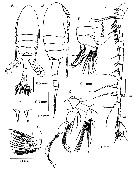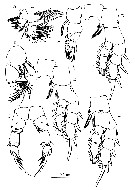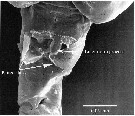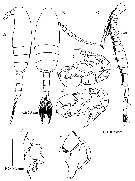|
|
 |
Fiche d'espèce de Copépode |
|
|
Calanoida ( Ordre ) |
|
|
|
Diaptomoidea ( Superfamille ) |
|
|
|
Pseudodiaptomidae ( Famille ) |
|
|
|
Pseudodiaptomus ( Genre ) |
|
|
| |
Pseudodiaptomus siamensis Srinui, Nishida & Ohtsuka, 2013 (F,M) | |
| | | | | | | Ref.: | | | Srinui & al., 2013 (p.42, Descr.F, M, figs.F, M, Rem.) |  Issued from : K. Srinui, S. Nishida & S. Ohtsuka in ZooKeys, 2013, 338. [p.43, Fig.2]. Female (from 12°41.14'N, 101°42.49'E): A-B, habitus (dorsal and lateral, respectively); C, rostrum (ventral view); D, right A1 (arabic numerals denote segment numbers); E, right A2; F, Md; G, Mx2. Nota : Cephalosome and 1st pedigerous somite fused, 4th and 5th pedigerous somites fused. Dorsolateral spines on 5th on 5th pedigerous somite. Urosome 4-segmented. Genital double-somite asymmetrical in dorsal view, elongate (ca. 2.54 times as long as wide) ; postero-dorsal and lateral margins with somewhat irregular row of spinules in ventral view ; genital area firnished with blunt, linguiform process midway, transverse rows of spinules anteriorly and paired flaps originating from genital opercula. Eaxh of paired egg-sacs consisting of 9-14 eggs, attached to lateral of genital opening. Proportional lengths of urosomites and caudal ramus 43 : 15 : 15 : 7 : 20 = 100. 2 nd and 3rd urosomites with row of minute spinules along postero-dorsal and lateral margins. Caudal rami with hair on inner margin and symmetrical with 6 setae (seta I absent, seta II with fine setules only along inner margin, setae III-VI plumose, seta VII located dorsally. A1 reaching beyond posterior end of genital double-somite, symmetrical, 22-segmented (segments 6-7 incompletely fused, segmenys 6, 15, 16, 18-21 each without aesthetasc. A2 coxa with single seta ; basis with 2 setae at inner corner ; endopod 2-segmented (1st segment with 2 setae, 2 nd segment with 7 and 8 setae on terminal and subterminal lobes, respectively, and lateral row of fine setules ; exopod 4-segmented (1st segment with 1 seta, 2 nd segment with 1 proximal, 2 medial and 1 terminal setae, 3rd segment with 3 setae, 4th segment with 1 medial and 3 terminal setae). Md with basis bearing 4 setae along inner margin ; endopod 2-segmented (1st segment with 4 setae, 2 nd with 9 setae ; exopod 5-segmented (1st to 5th segments with 1, 1, 1, 1, 2 setae, respectively. Gnathobase (coxa) with serrate dorsal seta and 3 cuspidate and 4 blunt teeth. Mx2 with 1st and 2 nd praecoxal endites having 4 and 3 setae, respectively ; 1st coxal endite with 3 long setae, 2 nd endite with 1 short strong and 2 long setae ; basis with 1 short and 2 long setae ; endopod with 9 setae.
|
 Issued from : K. Srinui, S. Nishida & S. Ohtsuka in ZooKeys, 2013, 338. [p.45, Fig.3]. Female: A, Mx1; B, Mxp; C, P1 (posterior view); D, P2 (posterior view); E, P3 (anterior view); F, P4 (posterior view); G, P5 (posterior view). Nota : Mx1with praecoxal arthrite bearing 9 trong and 6 fine setae and small spinules; coxa with 4 setae on endite and 9 setae on epipodite ; basis with 4 and 5 setae on proximal and distal endites, respectively ; basal exite with 1 seta ; endopod 3-segmented with 4, 4 and 6 setae from 1st to 3rd segments, respectively; exopod foliaceius with 10 setae along outer margin. Mxp with praecoxa and coxa completely fused ; endites with 0, 2, 3, 4 setae, respectively ; basis with 3 setae ; endopodal segment 6-segmented (1st segment with 2 setae, 2 nd segment with 2 bifurcated setae and 1 seta, 3rd and 4th segments with 1 bifurcated seta and 1 seta, 5th and 6th segments with 3 and 4 setae, respectively. P5 uniramous and almost symmetrical ; in posterior view, basis with short medial seta and spinular rows ; exopod 3-segmented, 1st segment produced into small pointed process at inner subterminal corner, with disto-lateral spine and one or two rows of spinules ; 2 nd segment having short and thickned disto-lateral process and medial serrate spine ; 3rd segment spiniform, tapering distally with inner spinules and proximo-medial spine.
|
 Issued from : K. Srinui, S. Nishida & S. Ohtsuka in ZooKeys, 2013, 338. [p.44]. Female: Setae (arabic numerals) and spine (Roman numerals) formula of swimming legs P1 to P4.
|
 Issued from : K. Srinui, S. Nishida & S. Ohtsuka in ZooKeys, 2013, 338. [p.48, Fig.5]. SEM micrograph of ventral side of genital double-somite of female Pseudodiaptomus siamensis, showing blunt process anterior to genital area.
|
 Issued from : K. Srinui, S. Nishida & S. Ohtsuka in ZooKeys, 2013, 338. [p.47, Fig.4]. Male: A-B, habitus (lateral and dorsal, respectively); C, right A1 (arabic numerals denote segment numbers); D, P5 (anterior view); E, P5 (posterior view); F, anterior view of exopod of right P5; G, postrior view of inner process and outer process of endopod of left P5. Nota : Urosome 5-segmented. Proportional lengths of urosomites and caudal ramus 13 : 25 : 21 : 17 : 11 : 13 = 100. Genital somite nearly symmetrical with 1 or 2 rows of spinules ventrally. Urosomites 1-4 with spinular row along posterior margin Caudal rami symmetrical, with 6 setae as in female. Right A1 geniculate and indistinctly 20-segmented
| | | | | NZ: | 1 | | |
|
Carte de distribution de Pseudodiaptomus siamensis par zones géographiques
|
| | | | Loc: | | | Gulf of Thailand (Prasae River Estuary).
Type locality: 12°42.66'N, 101°42.37'E. | | | | N: | 1 | | | | Lg.: | | | (1146) F: 1,29-1,41; M: 0,94-1,02; {F: 1,29-1,41; M: 0,94-1,02} | | | | Rem.: | Brackish waters. Euryhaline in the Prasae Estuary (Salinity between 0.7 and 23.3)
poppei-subgroup. | | | Dernière mise à jour : 05/02/2014 | |
|
|
 Toute utilisation de ce site pour une publication sera mentionnée avec la référence suivante : Toute utilisation de ce site pour une publication sera mentionnée avec la référence suivante :
Razouls C., Desreumaux N., Kouwenberg J. et de Bovée F., 2005-2025. - Biodiversité des Copépodes planctoniques marins (morphologie, répartition géographique et données biologiques). Sorbonne Université, CNRS. Disponible sur http://copepodes.obs-banyuls.fr [Accédé le 01 novembre 2025] © copyright 2005-2025 Sorbonne Université, CNRS
|
|
 |
 |







